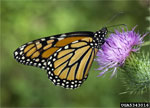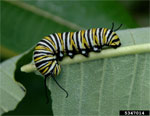Did you catch this year's monarch migration? Each fall, monarch butterflies begin their long southward migration from their breeding grounds to their overwintering sites. On the East Coast, monarchs migrate from eastern and central Canada and the eastern and mid-western United States to Mexico. There, in the cool, cloud-shrouded fir forests of Mexico’s central highlands, the monarchs cling in clusters to the branches, protected from the wind and awaiting the coming of spring. The peak period to see migrating monarchs in northern Virginia is from mid to late September.
 From the time monarchs arrive in our area in the spring until they pass through in large numbers in fall, several generations are born. The butterflies that make the fall journey to overwinter in Mexico are actually the grandchildren, or possibly even great-grandchildren, of the butterflies that warmed their wings during the lengthening spring Virginia days.
From the time monarchs arrive in our area in the spring until they pass through in large numbers in fall, several generations are born. The butterflies that make the fall journey to overwinter in Mexico are actually the grandchildren, or possibly even great-grandchildren, of the butterflies that warmed their wings during the lengthening spring Virginia days.
Unfortunately, like many of our pollinators, the intrepid monarchs are dwindling in numbers due to habitat loss and widespread herbicide use. In agricultural settings and along roadsides, the milkweed species that monarchs rely upon to feed their caterpillars are being depleted by herbicide spraying and roadside mowing. According to Monarch Watch, an organization dedicated to monitoring monarch migrations and conserving populations, development is eating up butterfly habitat in the United States at the rate of 6,000 acres a day!
 Monarchs, like most butterflies, have specific habitat needs. Each butterfly has a host plant or plants, which provides the butterfly’s larvae or caterpillars with food. Monarch larvae feed exclusively on milkweeds, the majority in the genus Asclepias. At least 8 species of milkweed in this genus are native to Fairfax County. The majority of these are available at native plant nurseries. In addition to milkweeds, adult monarchs need sources of nectar almost year-round. They prefer red, orange, yellow or purple nectar-rich flowers in sunny areas. Adjacent areas with shrubs or trees help shelter the butterflies from wind and provide resting places for the larvae and pupae.
Monarchs, like most butterflies, have specific habitat needs. Each butterfly has a host plant or plants, which provides the butterfly’s larvae or caterpillars with food. Monarch larvae feed exclusively on milkweeds, the majority in the genus Asclepias. At least 8 species of milkweed in this genus are native to Fairfax County. The majority of these are available at native plant nurseries. In addition to milkweeds, adult monarchs need sources of nectar almost year-round. They prefer red, orange, yellow or purple nectar-rich flowers in sunny areas. Adjacent areas with shrubs or trees help shelter the butterflies from wind and provide resting places for the larvae and pupae.
In 2005, alarmed by the decreasing populations of overwintering monarchs, Monarch Watch launched the Monarch Waystation project. This project encourages the creation of monarch habitat in school, church, residential, commercial and municipal landscapes in an effort to support monarchs as they undertake their lengthy, annual migration. The term “waystation” refers to the food and fuel stops along railroads lines and Pony Express routes in the 19th century. The Monarch Waystation project is the brainchild of Orley Taylor, the director of Monarch Watch and a University of Kansas ecology professor who has been studying monarchs for over 15 years.
Any piece of land can become a Monarch Waystation! You can create a monarch habitat from scratch or modify an existing landscape space. Locate your Waystation garden in a sunny space, receiving more than 6 hours of sun a day, and include 10 milkweed plants and at least 4 plants that provide nectar for adult monarchs. With these elements, and a plan in place to maintain and nourish your Waystation, you can have your garden certified by Monarch Watch to show that you are participating in monarch conservation.
The organization will add your name to the registry of over 2000 certified Monarch Waystation gardens. For a few extra dollars you will be sent an official Monarch Waystation sign that describes the purpose of your garden to visitors.
At least seventy gardens in Virginia are registered as Monarch Waystations. Included are gardens at several local schools, such as Spring Hill and Ravensworth Elementary, numerous residential gardens, and Meadowlark Botanical Gardens, the Northern Virginia Regional Park garden in Vienna.
The application and certification requirements can be downloaded from the Monarch Watch web site (http://www.monarchwatch.org/waystations/). You can also contact MonarchWatch toll-free by phone at 1-888-TAGGING.
Monarch Watch is striving for 10,000 certified Monarch Waystations. Consider turning your bit of earth into a waystation garden for wildlife, and especially for the migrating monarch.
Photo credits: David Cappaert, Michigan State University (monarch adult); William M. Ciesla, Forest Health Management International (caterpillar); bugwood.org
Milkweeds for Fairfax County Waystations
Rose, red or purple flowers
Swamp milkweed (Asclepias incarnata) – common, likes average-wet sites
Purple milkweed (Asclepias purpurascens) – easy to grow, prefers dry sites, can take partial shade
Red milkweed (Asclepias rubra) – prefers wet sites
Orange flowers
Butterflyweed (Asclepias tuberosa) – common, dry to moist meadows and roadsides
Dusty pink or purple flowers
Common milkweed (Asclepias syriaca) – somewhat weedy, fragrant flowers, dry fields and roadsides
Blunt-leaved milkweed (Asclepias amplexicaulis) – prefers dry, sandy soils
Green, pale pink or white flowers
Whorled milkweed (Asclepias verticillata) – fine-textured foliage, fragrant flowers, prefers dry sites
Four-leaved milkweed (Asclepias quadrifolia) – habitat is dry woods
White milkweed (Asclepias variegata) – white flowers with purple centers, habitat is dry woods
Green milkweed (Asclepias viridiflora ) – habitat is dry, sandy woods and clearings

